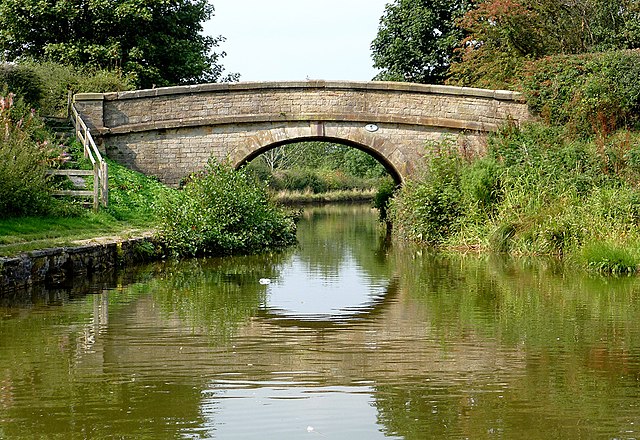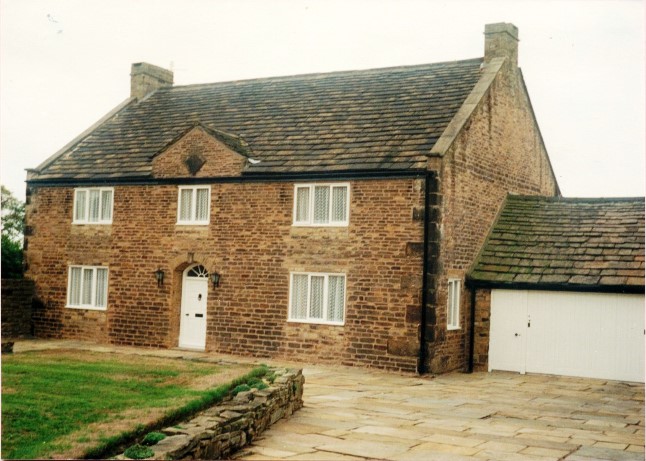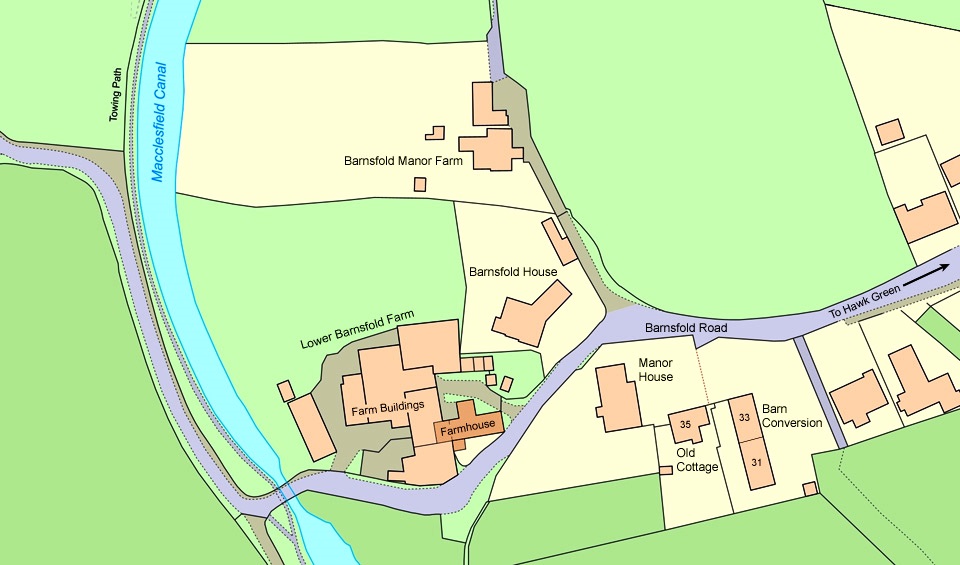To travel from Marple towards High Lane, you will set off along Hibbert Lane, and cross the Macclesfield Canal using Ecclesbridge when the road becomes Upper Hibbert Lane, and steepens, passing Goyt Mill on the right, and the 1686 house (oldest in Marple) on the left, with the Reading Room on the right. Just beyond, the road flattens out and becomes known as Windlehurst Road and will take you to the Horse Shoe traffic lights junction with the A6 in High Lane. Back in Hawk Green, the start of Windlehurst Road is at a cross roads with Hawk Green Road and Barnsfold Road, and it is down here we shall go today. For most this is the access to Marple Golf Club, but long before we get there, and just before we cross the Macclesfield Canal by Bridge 5, we come to the hamlet of Barnsfold. Until recently this was a community of just four dwellings, but in the last few years conversions of old buildings have added three to the total.

Bridge No. 5 Macclesfield Canal
Barnsfold is a community of great antiquity, thought to be the only place in the Marple area mentioned in the Domesday Book of 1086 which stated that there was a virgate (about 30 acres) of woodland called Laitone here. There are several Laitones about, so this may not be the precise location, and we must remember that it was a very different place then. The Macclesfield Canal only arrived in 1832. However, we do have documentary evidence that this was a farming community in 1672 when the area was owned by George Barns (hence the name) and who left some interesting bequests in his will of 15 November 1699.
He made part of his lands subject to a yearly rent charge which was to be used for charitable purposes. He didn’t provide all this money, he expected his tenants to pay some of it. Collecting 20/- from Isobel Higginbotham and her son Oliver on St Martin’s Day, and 2/- from Thomas Booth on the Feast of the Annunciation and Michael the Archangel, this to go to the Schoolmaster.
Mr Bradshaw, Henry Bardsley (tanner), William Dale, John Bullock, Henry Beeley were appointed as Trustees to administer the bequest, and had to pay out £8 per year to apprentice boys to husbandry or other useful work. 20/- for the Preacher at the Chapel, if in want (this would be All Saints Chapel of Ease) 20/- for the Preacher to be Schoolmaster in the Public Schoolhouse in Marple. The money to revert to the Trustees if the Schoolhouse was empty, if the Schoolmastership was vacant for a year, the money to be used for repairing the roads in Marple! This charity remained in place, though did not operate for many years, and was eventually closed down in the 1990s.
Fast forward a little to the first proper census of 1841, which states that 75 people lived at Barnsfold. Ten years later the 1851 Census records that the numbers had risen to 85, living in at least eleven dwellings. 32 working in different aspects of the textile industry, 7 people in farming, 3 were concerned with the Macclesfield Canal (which had opened in 1832), there was a hatter, a blacksmith, 2 wheelwrights, 2 coal miners, plus 36 elderly people and children who were not part of the workforce.
Seven of those dwellings had been demolished before the start of the 21st Century, leaving Barnsfold Manor Farm and the Manor House which are both Grade II listed, plus Lower Barnsfold Farm and Barnsfold House, a newbuild of 1996 on the foundations of an existing house. The Manor House had a barn and a rundown cottage in its curtilage. In the last few years the barn has been converted into two dwellings, and the cottage enlarged and modernised. So now there are seven dwellings, and no decrepit buildings, but only Lower Barnsfold Farm still carries on any kind of farming!
The oldest of these properties is known today as Barnsfold Manor Farm, though until a few years ago the locals called it Abbot’s Farm because it was owned and lived in by Mr Abbot. ‘Manor’ is not a correct term as this is not a manor in the Norman sense of the word, but a tenanted farm in the territory of the Manor of Marple and Wybersley, of which the manor house was Marple Hall. The earliest part of the house has a date stone of 1659 GE, and has been extended later at the rear where there is another (worn) datestone stating possibly IMB 1739. It is mostly constructed of dressed stone, having a stone flagged roof. (It has been beautifully reroofed by the present owners using the original roof stones.) It has an L-shaped plan, with the 1739 wing added at the rear, and is surrounded by lovely gardens and orchard. The gabled garden frontage has 4 and 5 light mullioned windows on the ground floor, and similar, but both 4 light mullioned windows to the first floor and stylish finials at the corners of the roof. The prominent, 2 storey entrance porch around the corner is thought to have been a small factory, possibly a hatworks. Old photos show it with an industrial style chimney and outside steps leading to a door at first floor level. You can still see the cut off ends of the steps in the present stone work. It would have been common for farmers to have an interest in felt hat making as a use for the pelts of rabbits they would have potted to protect their crops.
The other listed property is designated The Manor House in the listing, but this is a modern status symbol because, as stated above, Barnsfold has never been a manor in the Norman sense. This is a much later property than Barnsfold Manor Farm. There is a wooden or stone panel in the central gable above the front door with a painted date which could be 1659, but this is almost certainly a pastiche, as the style of the present building is assigned early 18th Century in the listing entry.

Manor House
Across the road from here is the rebuilt Barnsfold House. The original house, then called Barnsfold Cottage, was the residence of the Oldfield family. Jack Oldfield came from Mellor and made his living by dry stone walling. He married Lizzie Pott and they lived at Barnsfold Cottage, which is where Lizzie’s family came from. When Jack Oldfield died in the early 1990s, the family made attempts to rebuild the cottag, but lack of money and family arguments caused the project to falter, and eventually the property was bought by a builder, who cleared the derelict outbuildings, and constructed a large modern stone-faced house, with integral garage and granny flat above, on the footprint of the original dwelling. A nice touch is the modern datestone on the gable over the front entrance, leaving us in no doubt that the building was constructed in 1996.
The last building we pass, on the way to cross the Macclesfield Canal on Bridge 5, is Lower Barnsfold Farm, a typical base-of-the-Pennines longhouse farmstead with its farmyards to the sides and rear. (No listing or definite dating here, but given that it is stone built and has some of the original mullioned windows, I’d give it early to mid eighteenth century, similar to the Manor House on the other side of the road.
And so we have reached the end of Barnsfold. If you carry on down the road for a bit you cross the canal on Bridge 5 and then you can take the flight of steps on to the towpath and so to Upper Hibbert Lane, and back to Marple, or retrace your steps along Barnsfold Road for refreshment at the Crown.
Judith Wilshaw - February 2024
Based on extensive research by Claire Wilshaw, and an archaeological survey of Barnsfold Manor Farm conducted by Mellor Archaeological Trust in May 2008.









